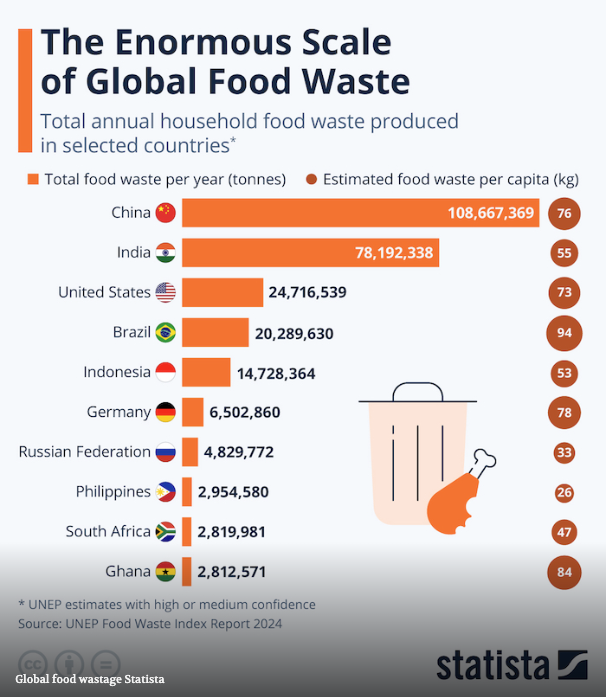According to a Statista story by Anna Fleck this morning, more than US$ one trillion worth of food is thrown away each year, while at the same time, up to 783 million people are affected by hunger. At the same time, food waste generates an estimated 8-10% of global greenhouse gas emissions and takes up the equivalent of nearly 30% of the world’s agricultural land. These are just some of the findings published in the United Nations Environment Programme’s Food Waste Report 2024.
The UNEP estimates that in 2022, the world produced 1.05 billion tonnes of food waste across the retail, food service and household sectors. The average amount of food waste per capita that year is estimated to be 132 kg, of which 79 kg was household waste. This equates to roughly 19% of food available to consumers being wasted across the retail, food services and household levels. This is a problem seen across all levels of society, reflected in how the figure for household waste is broadly similar across country income groups at 81 kg per capita for high income, 88 kg per capita for upper middle, 86 kg for lower-mid income, presumably in high and middle income countries, while there was insufficient data for lower income countries.
When looking at the data on a country-by-country basis, the highest absolute figures for food waste were recorded in the two countries with populations of more than a billion people. China wastes an estimated 108.7 million tons of food per year while India discards 78.1 million tons. The United States creates 24.7 million tonnes of food waste annually, while in Europe, France and Germany produce between 3.9 and 6.5 million tonnes per year. At the lower end of the spectrum, come South Africa and Ghana, each with closer to 2.8 million tons of food waste per year.
Things look rather different when it comes to waste produced per capita. For example, the average household in India discards 55 kg of food per year while for the United States the figure is 73 kg. By comparison, the Philippines’ total household waste comes to just below 3 million tonnes each year with waste per capita only coming to 26 kg.
The Indian Save Food Movement and the FoodTekPack
While the above brief article suggests that more details are needed to pinpoint where in the food supply chain the waste occurs in various societies there is a belief among Indian experts that the greatest wastage of food in India is at farm level while in the advanced economies it is at the consumer end. In our country large amounts of crops and produce never reach the supply chain or the market and simply rot in the fields. There is a need for an Indian Save Food Movement that looks at the entire food supply chain in order to bring more food products and protein to customers. Whether this requires better and regenerative farming innovations, a better cold chain, or a better systems for processing and the supply chain, it is likely that technology will play an important role.
It is clear that a circular food economy with innovations from farm to thali are key to achieving the overall sustainability in terms of energy, water, seeds, fertilizer, land use, processing innovations and responsible packaging. The Food Tek Pack conference in Greater Noida on 11 and 12 December aims to looks at the food supply chain and its processing and packaging needs in a holistic way as a part of coherently expanding the Indian Save Food movement.











